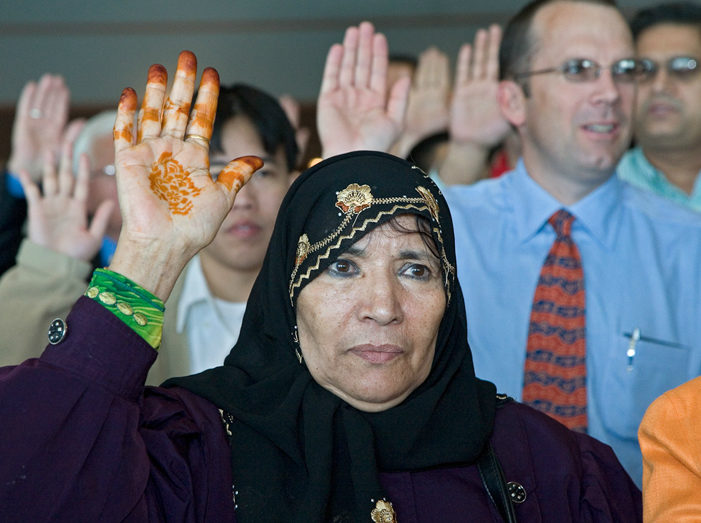Raquel Garcia is amazed by what she often learns from knocking on doors in Southwest Detroit.
Hired to communicate with local immigrants about the personal and professional resources they might need, she frequently finds they’ve fared relatively well with little support outside their inner circles.
Possessing a capacity for self-sustenance and more often than not a survivor mentality are typical of many immigrant neighborhoods throughout the city, state and nation.
“They have businesses and they’re functioning in the community, but they have trouble accessing municipal services and utilizing available information, particularly if they don’t speak English,” says Garcia, director of partnership and community outreach for Global Detroit.
Possessing a capacity for self-sustenance and more often than not a survivor mentality are typical of many immigrant neighborhoods throughout the city, state and nation. But not only are Detroit’s and Michigan’s immigrant residents striving to better themselves, they’re contributing to the workforce and economy in largely overlooked ways. Through Global Detroit, Garcia, her colleagues and supporters are working to dispel myths that immigrants hinder local cities, as anti-immigration sentiment has publicly increased.
“No major American city has rebounded from population decline without the help of immigration.” -Steve Tobocman, Executive Director, Global Detroit
An inaugural study by the non-profit Global Detroit following its launch in 2009 showed Rust Belt cities like Detroit boasted immigrant populations who were twice as likely to have college degrees as non-immigrants. The research also showed no major American city has rebounded from population decline without the help of immigration, says Steve Tobocman, Global Detroit’s executive director.
“I’ve been doing this for almost eight years now, and I’m constantly reading something that deepens my commitment and understanding,” Tobocman says.
“New Americans in Detroit,” found that immigrant-owned Detroit businesses generated $15.5 million in business income in 2014.
While he increases his own knowledge about immigration’s challenges and benefits to urban cities, Tobocman and Global Detroit have also been prolific in generating information.
Undeterred by increased anti-immigrant sentiment and openly growing resentment toward foreign-born citizens since the 2016 presidential election, he says research proves more diverse neighborhoods and cities succeed.
 “The other side of the equation has delved into fear-mongering and imagery,” he says, “when the facts and numbers are on our side.”
“The other side of the equation has delved into fear-mongering and imagery,” he says, “when the facts and numbers are on our side.”
This week—September 15-24—just happens to be Welcoming Week, too, the annual national celebration bringing together thousands of people across multiple events that celebrate the contributions of immigrants and refugees and their role in communities.
“Michigan: We Are All Immigrants Here,” a recent 20-page study authored by the Michigan Economic Center and Global Detroit, traces the state’s years of development and transformation by Canadian, German, Dutch, and other immigrants who once manned lumber camps and paper mills to the contributions of other Great Lakes state immigrants today. Other findings include:
- Michigan’s immigrant population, totaling 650,000 foreign-born residents, grew 24.5 percent, while native-born populations declined 1.5 percent from 2007 to 2017.
- Between 2010 and 2014, 52,000 people immigrated to Michigan at a time when the state population grew by just 38,000.
- Detroit saw the immigrant population grow 13 percent from 2010 to 2014, even as Detroit’s overall population fell.
- 31,000 immigrants are self-employed, and immigrant-owned businesses employ more than 150,000 others.
- While comprising just 6 percent of the population immigrants form 30 percent of Michigan’s doctors, 28 percent of its software developers, and 22 percent of its mechanical engineers.
Even Michigan scholars, who represent 32,000 international students, impact $1.02 billion in spending, Tobocman says. Global Detroit launched the International Student Retention Program as a strategy to prevent talented graduates from leaving Detroit and the state.
Emphasizing neighborhoods and entrepreneurship, building the region, and policy research that includes immigrant rights, Global Detroit also works with DTE Energy, Ann Arbor-based software company Llama Soft and other corporate supporters.

“Even going beyond the city, most people are not aware Detroit is a national leader in immigrant economic integration,” says Tobocman.
Similarly, Michigan has more Welcoming Cities – those that promote themselves as friendly to immigrants – than any other state, including largely Mexican-immigrated California, he says.
Another report, “New Americans in Detroit,” found that immigrant-owned Detroit businesses generated $15.5 million in business income in 2014.
Gracie Xavier, director of corporate and economic development strategy, oversees Global Detroit’s Global Talent Retention Initiative, which helps support resources for 3,200 jobs.
Additional allies and programs that complement the organization’s mission include Southwest Solutions and ProsperUS Detroit, which provides training to entrepreneurs.
In the years since Global Detroit was formed, Dayton, Cleveland, St. Louis, Pittsburgh and other Midwestern cities have developed immigrant-centered programs, says Tobocman. Global Detroit oversees Welcoming Economies Global Network, a 10-state organization.
Locally, the organization sees Southwest Detroit, Hamtramck, Banglatown, Chaldean Town, and Cody Rouge as neighborhoods for opportunity to increase its work.
“It really is a win-win for the city,” Tobocman says.
Editor’s Note: TheHUB’s Neighborhood Economic Development Director Rob Dewaelsche contributed to this article.
Photos by Jim West


